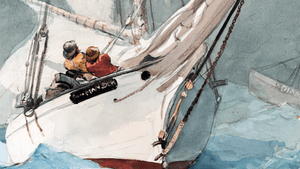Stay in the Loop
BSR publishes on a weekly schedule, with an email newsletter every Wednesday and Thursday morning. There’s no paywall, and subscribing is always free.
American watercolor: A Philadelphia story
Philadelphia Museum of Art's Watercolor in the Age of Homer and Sargent

Winslow Homer and John Singer Sargent were not Philadelphians, yet the exhibition now at the Philadelphia Museum of Art celebrating their influence on American watercolor is dominated by artists who lived and worked here. To understand our city’s importance in the advent of the medium, it’s necessary to step back in time to when watercolor was the stepsister of the art world.
Until the mid-19th century, oil paint and pastels were considered the only acceptable mediums for museum-quality art, with oils most prominent. Watercolor was disdained by European artists, who only used it for preliminary sketches, unworthy of display. Meanwhile, here in the States, watercolor was considered a suitable hobby for “ladies” and was used by commercial illustrators.
An American medium
Then the unthinkable occurred. A group of New York artists formed the American Watercolor Society, promoting the medium among established oil painters and welcoming into their ranks illustrators and other commercial artists. This inclusivity was nothing short of revolutionary. (Think Keith Haring meets Thomas Eakins.) Their first exhibition, in 1867, broke down barriers that kept watercolor and illustrators out of museums. It gave American artists a medium in which they were second to none.
Which brings me back to Philadelphia’s role in the history of American watercolor. Yes, we have the Pennsylvania Academy of the Fine Arts, the nation’s first art school, where many of the artists featured in the exhibition studied or taught. But more importantly, in the mid-19th century, Philadelphia was the nation’s publishing capital. Curtis Publishing employed leading illustrators who, overnight, went from being commercial artists to respected painters. That watercolors were less expensive than oil paintings and could be reproduced inexpensively didn’t hurt. (Whose grandparents didn’t have a Parrish print?)
Organized around the history of American watercolor, the exhibition starts with British-influenced paintings heavy on detail and traditional composition. The paint is opaque, the brushstrokes all but invisible, giving little indication of watercolor’s potential as a transparent, spontaneous medium. I all but ran through these rooms until I reached the looser approach taken by contemporaries of Homer and Sargent. This is where the fun starts.
Setting sail
Suddenly, the subject matter is no longer static or serene. Homer (1836-1910) gives us turbulent seas, crews wrestling sails, and threatening skies. His paintings reflect his love of travel, adventure, and nature. Sargent (1856-1925), whose star was rising just as Homer’s was fading, reflects a more luxuriant lifestyle. His ships are sun-drenched yachts and Venetian gondolas. Sargent was an affluent Italian-born American, and his images have a romantic, grandiose elegance. One imagines that when he didn’t have a brush in hand, he held a champagne flute.
While the exhibition begs the question, “Who was the better artist, Homer or Sargent?” I have no doubts. It was Sargent. (Sorry, I’m not open to debate.) His paintings not only capture light, they radiate it. Working in Paris and Venice, as well as in the United States, Sargent’s work appears to have been more influenced by European Impressionism than Homer’s work. This is most apparent in Sargent’s “Group (Siesta in a Swiss Wood).” The brush strokes are dappled, taking cues from Seurat and Van Gogh.
However, the real surprises of this exhibition are the watercolors of Charles Demuth, Georgia O’Keeffe, Max Brenner, and Man Ray. Created at the cusp of modernity, their paintings are striking in foreshadowing all that was to come.
What, When, Where
Watercolor in the Age of Homer and Sargent. Through May 14, 2017, at the Philadelphia Museum of Art, 2600 Benjamin Franklin Parkway, Philadelphia. (215) 763-8100 or philamuseum.org.
Sign up for our newsletter
All of the week's new articles, all in one place. Sign up for the free weekly BSR newsletters, and don't miss a conversation.

 Stacia Friedman
Stacia Friedman